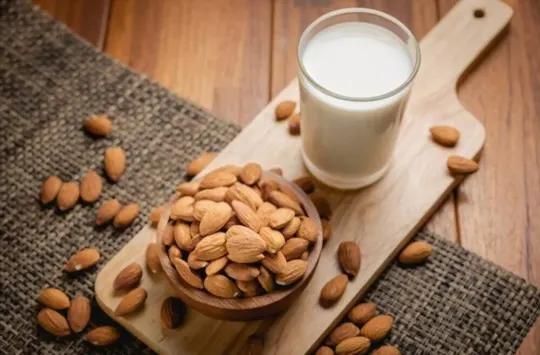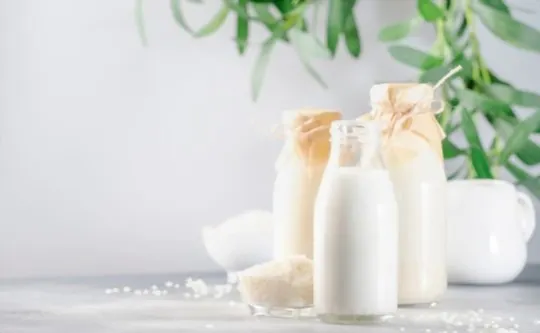Pancakes are a delicious treat that can quickly turn into a go-to for breakfast, lunch or dinner.
But what exactly do you do when you don’t have any milk on hand?
We’ll take an in depth look at five different types of substitutes to help get your pancakes batter just the right texture without needing cow’s milk.
From class oat milk to making almond milk from scratch – we explore all the options and walk you through each one’s pros and cons.
Plus, so much more about why these alternatives might be better than cow’s milk!
Read on to find out which one is best for your needs and start putting together some tasty pancake recipes today!
What Type of Milk is Good for Pancake?

Making pancakes can be a fun morning activity to do with the family.
But what type of milk is best for creating a fluffy batter? Depending on who you ask, you’ll likely get many different answers.
Milk options range from cow’s milk, almond milk, coconut milk and so much more.
But if you want the batter that is light and airy perfect for any pancake occasion, it is best to go for whole milk.
Whole cow’s milk offers the highest level of fat for the fluffiest pancake stacks.
When making pancakes from scratch, make sure not to overmix your batter to ensure a tender stack topped with butter and syrup which won’t become tough from overworking.
Remember that experimenting with some of the aforementioned alternatives such as almond or coconut milk could result in successful stacks too.
Why Use Milk for Pancakes? Can You Make Pancakes without Milk?
Making pancakes can be a delicious treat.
But why use milk in the batter? Many people may find it perplexing to wonder why this traditional ingredient is so important to make the perfect pancake.
Well, dairy milk creates a light, fluffy texture in pancakes by aerating them.
The proteins in the milk help form gluten structures, adding more body and moisture to the batter.
If you don’t have dairy milk at home, you can still make your pancakes without it.
Other kinds of liquid ingredients like yogurt and nut-based milks make for equally as delicious tasting pancakes.
What’s more, using non-dairy alternatives yields some added benefits – a healthier choice for those looking to avoid saturated fats; a lactose-free alternative for people avoiding dairy; and potentially important allergen-friendly ingredients when choosing nut milks.
Whether you decide to use regular or alternative milks – both options will deliver delicious flapjacks.
5 Best Milk Substitutes for Making Pancakes
Milk is a popular ingredient in pancakes and other breakfast fare, but not everyone enjoys or has access to it.
Fortunately, there are plenty of delicious and nutritious non-dairy alternatives available that will make your pancakes just as light, fluffy and flavorful as the traditional recipe.
The most common non-dairy options include:
1 – Soy Milk

Soy milk is a great milk substitute for pancakes if you’re looking for a dairy-free option.
It has a similar taste and texture to cow’s milk, so it works especially well if you’re trying to replicate the flavor of traditional pancakes.
Just be sure to use an unflavored version as some flavored soy milks have added sugar that may change the flavor of your pancakes.
You can also add sweeteners and spices like cinnamon or nutmeg to give it extra flavor profiles.
Soy milk can also help make your pancakes lighter and fluffier due to its higher fat content.
2 – Oat Milk

Oat milk is an alternate choice for those with lactose allergies.
It’s made from oats and water and is one of the simplest plant-based milks to make.
It has a creamy, slightly sweet taste that works well with savory or sugary ingredients in pancakes.
Oat milk adds a touch of sweetness to the pancakes but not enough to be overpowering.
It also helps keep the pancakes moist since oat milk has more fat content than almond or soy milk varieties.
Additionally, it’s quite nutritious providing several essential vitamins and minerals including riboflavin, zinc, folate and fiber.
Some store-bought brands also contain added calcium which helps support healthy bones.
Oat milk pairs best with lighter pancake recipes such as classic plain or blueberry pancakes.
3 – Almond Milk

Almond milk is a great choice if you have a lactose intolerance or are vegan.
It contains less fat than cow’s milk and can provide a substantial amount of calcium, though not as much as cow’s milk.
To make an almond milk variant, start by steeping 2 tablespoons of ground almonds in 1 cup of warm water for at least 20 minutes.
Then, strain out the solids with a fine-mesh sieve or cheesecloth and add salt and sugar to taste.
This almond milk mixture will not be as thick and creamy as cow’s milk-based batters, but when cooked properly it should create fluffy pancakes that hold together nicely.
4 – Rice Milk

Just like soy milk, rice milk has a milder and sweeter taste compared to cow’s milk.
This makes it the perfect alternative to cow’s milk when making pancakes.
Did you know that rice is actually one of the oldest grains used in culinary arts?
Rice milk is made from boiled rice, brown rice syrup and brown rice starch.
It is often enriched with calcium and other vitamins needed for a balanced diet.
If you choose to use rice milk, you’ll need to add relatively more liquid than when using cow’s milk as the consistency of it becomes thinner when heated up.
Rice milk can be used as an alternative for sweetened or unsweetened dairy products in baking recipes that call for buttermilk or regular cow’s milk.
Be sure to check the label: some brands contain gluten, so if you’re making gluten free pancakes this isn’t your best option.
5 – Hemp Milk

Hemp milk is a top choice for people following a vegan lifestyle, and is made from hemp seed hearts.
When combined with the perfect pancake recipe, it can give an excellent result in terms of texture, taste and appearance.
Since this milk has less sugar than other vegan alternatives like soy or almond, it might be one of the best options for those who are looking for something light and low in calories.
Just make sure to adjust your recipes so that they don’t become too dry or heavy.
Hemp milk also contains healthy amounts of Omega-3, iron and calcium which makes it a good option if you are looking to add nutrition to your pancakes.
Conclusion
When it comes to making pancakes, the choice of substitute for milk is ultimately an individual decision, based on dietary restrictions and personal preference.
Each of the above alternatives has advantages and disadvantages that should be taken into account before making a selection.
From flaxseed milk, to extra light olive oil, to coconut cream, all of these options can give you delicious, fluffy pancakes without taking away from their original flavor.
For those who choose not to use cow’s milk, but would like a dairy option, there are substitutes such as almond or oat milk that provide the same viscosity without introducing any additional flavors or ingredients that may interfere with the taste or texture of your pancakes.
Whatever substitution you ultimately decide on for your pancakes, remember that it won’t change how much you enjoy them.
So why use milk? You don’t have to.
Frequently Asked Questions
What are the benefits of using milk for pancakes?
Using milk in pancakes adds moisture, flavor, and richness.
Additionally, it helps to make the pancakes light and tender.
What are the best substitutes for milk when making pancakes?
The five best substitutes for milk when making pancakes are coconut milk, almond milk, yogurt, buttermilk, and soy milk.
How do I use the substitutes for milk when making pancakes?
You can use the substitutes for milk when making pancakes by substituting them in the same measure you would use milk.

5 Best Milk Substitutes for Making Pancakes
Ingredients
- 1 – Soy Milk
- 2 – Oat Milk
- 3 – Almond Milk
- 4 – Rice Milk
- 5 – Hemp Milk
Instructions
- Choose your preferred substitute from the list of options.
- Organize all of your ingredients.
- Use the proper substitute to cook your recipes.

Carrie is a food writer and editor with more than 15 years of experience. She has worked for some of the biggest names in the food industry, including Bon Appétit, Food & Wine, and Martha Stewart Living.
As the Editor in Chief of IntroChicago.com, Carrie oversees all of the content on the site. She also manages the team of contributing writers and editors, who help to create delicious recipes, helpful tips, and informative articles that you’ll find on the site.
A native of the Chicago area, Carrie is passionate about all things food. She loves trying new restaurants and experimenting with new recipes in her kitchen. She’s also a graduate of the Culinary Institute of America, so she knows a thing or two about food!
